How Management Motivation Impacts Employee Retention: A Report
VerifiedAdded on 2019/12/03
|15
|3541
|36
Report
AI Summary
This report delves into the crucial role of management motivation in fostering employee retention within organizations. It examines the significance of employee motivation in achieving organizational success, emphasizing how motivated employees contribute to providing quality products and services. The report highlights the importance of effective management policies, including creating a positive work environment, offering monetary and non-monetary benefits, and implementing motivational theories. It explores both intrinsic factors like work quality and growth, and extrinsic factors such as company policies and supervisor styles. The research methodology involves a constructivist approach, utilizing both primary data from questionnaires and secondary data from literature reviews. The study aims to assess the effectiveness of various management strategies, including those used by Sun mark ltd., and provides recommendations for enhancing employee retention through improved management practices.
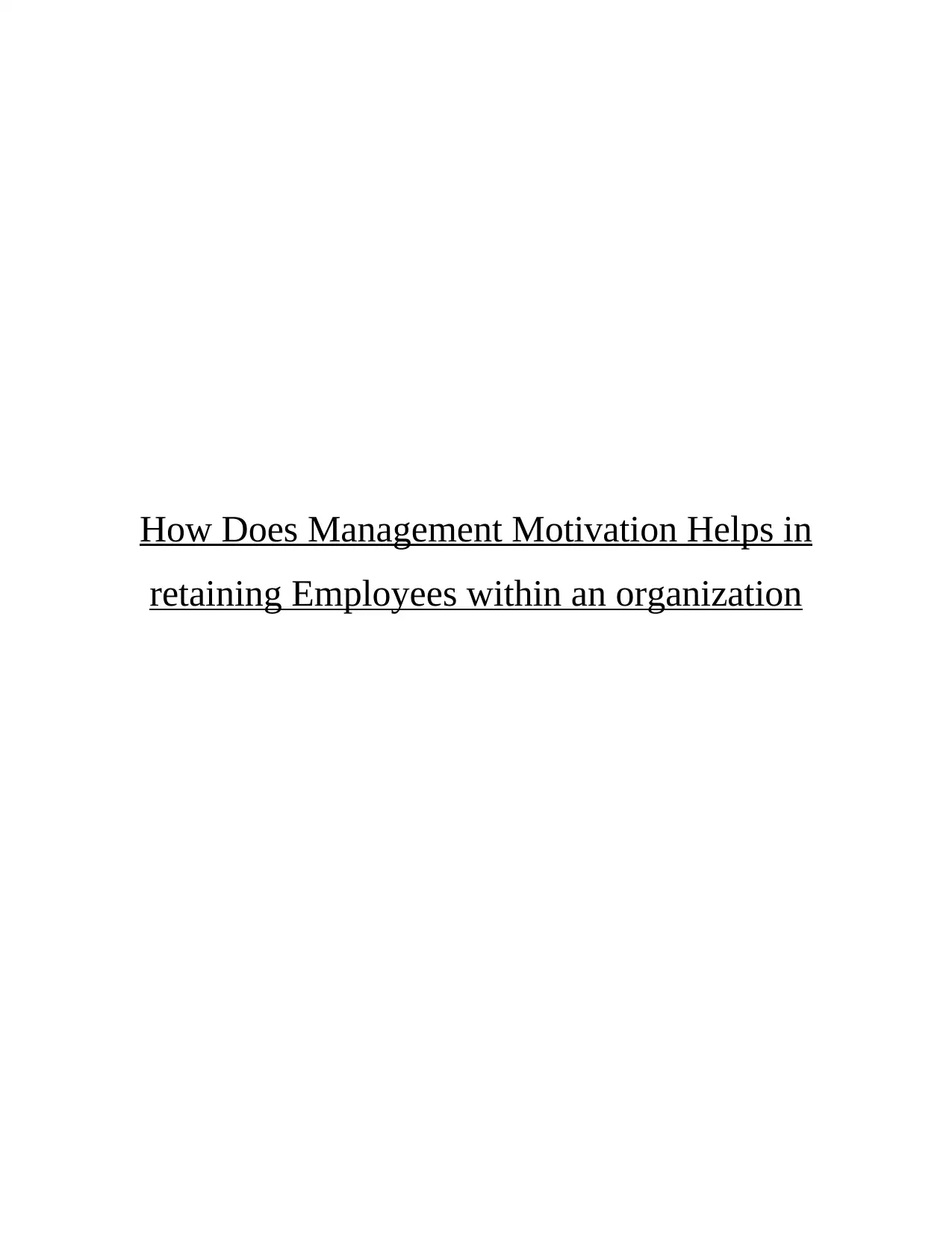
How Does Management Motivation Helps in
retaining Employees within an organization
retaining Employees within an organization
Paraphrase This Document
Need a fresh take? Get an instant paraphrase of this document with our AI Paraphraser
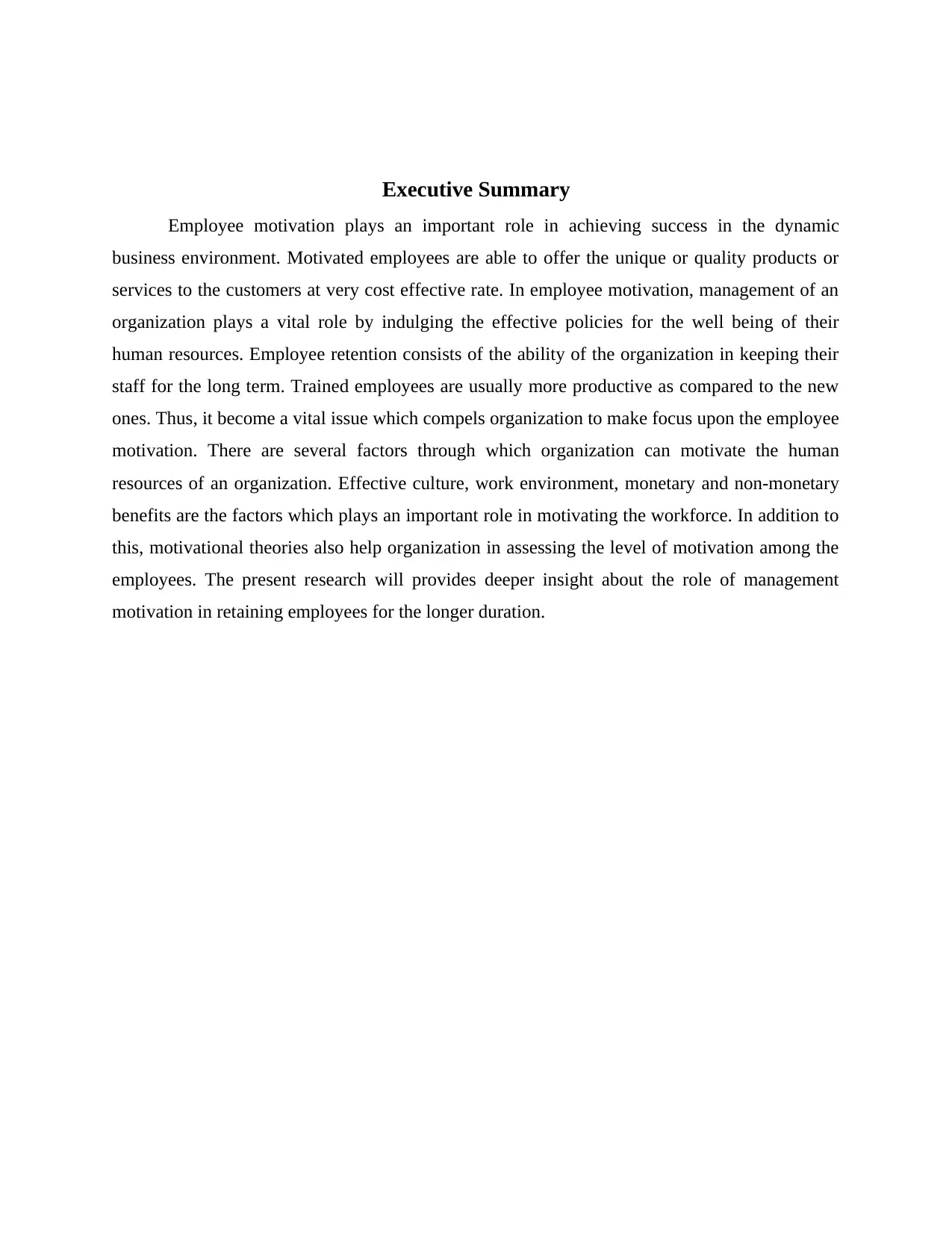
Executive Summary
Employee motivation plays an important role in achieving success in the dynamic
business environment. Motivated employees are able to offer the unique or quality products or
services to the customers at very cost effective rate. In employee motivation, management of an
organization plays a vital role by indulging the effective policies for the well being of their
human resources. Employee retention consists of the ability of the organization in keeping their
staff for the long term. Trained employees are usually more productive as compared to the new
ones. Thus, it become a vital issue which compels organization to make focus upon the employee
motivation. There are several factors through which organization can motivate the human
resources of an organization. Effective culture, work environment, monetary and non-monetary
benefits are the factors which plays an important role in motivating the workforce. In addition to
this, motivational theories also help organization in assessing the level of motivation among the
employees. The present research will provides deeper insight about the role of management
motivation in retaining employees for the longer duration.
Employee motivation plays an important role in achieving success in the dynamic
business environment. Motivated employees are able to offer the unique or quality products or
services to the customers at very cost effective rate. In employee motivation, management of an
organization plays a vital role by indulging the effective policies for the well being of their
human resources. Employee retention consists of the ability of the organization in keeping their
staff for the long term. Trained employees are usually more productive as compared to the new
ones. Thus, it become a vital issue which compels organization to make focus upon the employee
motivation. There are several factors through which organization can motivate the human
resources of an organization. Effective culture, work environment, monetary and non-monetary
benefits are the factors which plays an important role in motivating the workforce. In addition to
this, motivational theories also help organization in assessing the level of motivation among the
employees. The present research will provides deeper insight about the role of management
motivation in retaining employees for the longer duration.
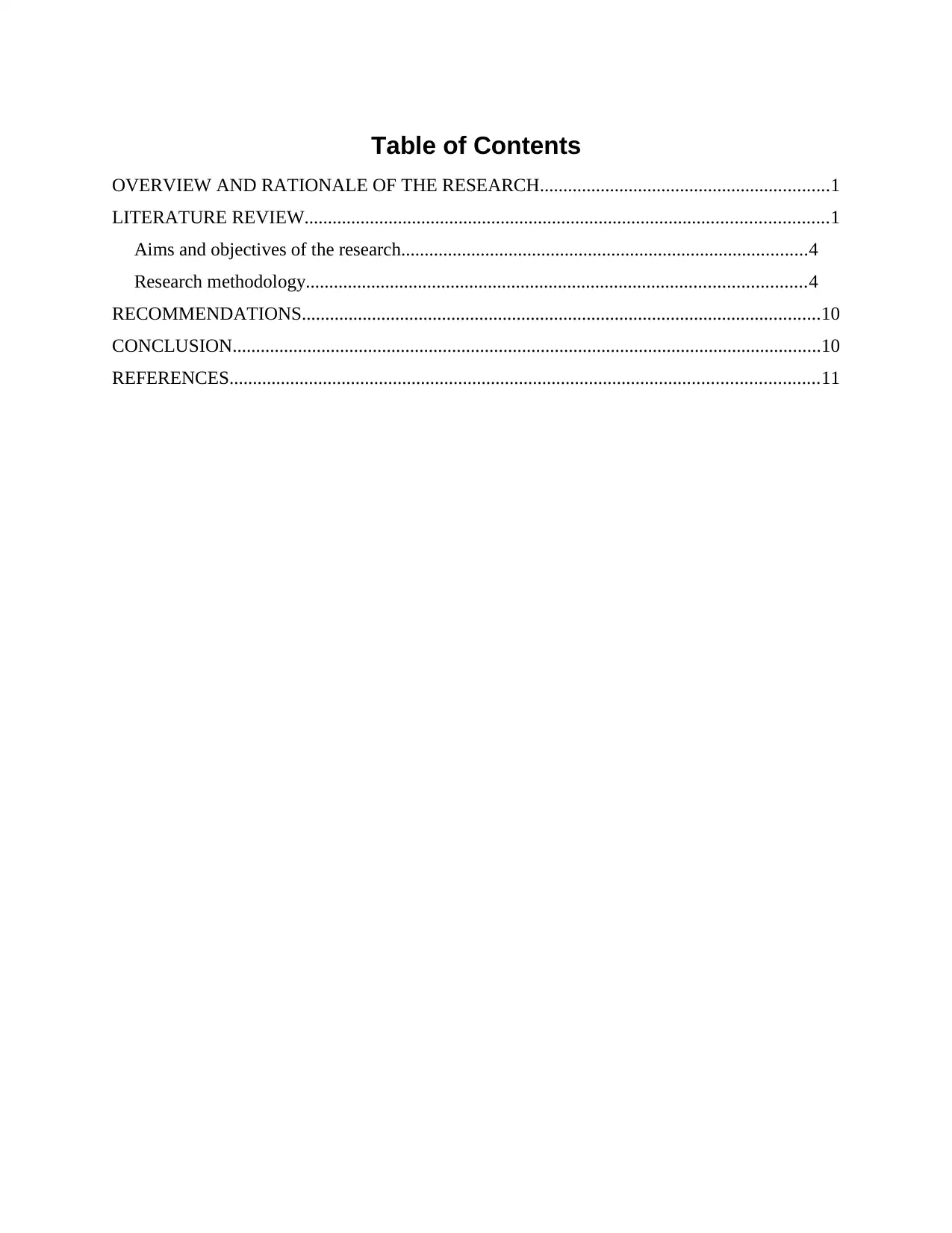
Table of Contents
OVERVIEW AND RATIONALE OF THE RESEARCH..............................................................1
LITERATURE REVIEW................................................................................................................1
Aims and objectives of the research.......................................................................................4
Research methodology...........................................................................................................4
RECOMMENDATIONS...............................................................................................................10
CONCLUSION..............................................................................................................................10
REFERENCES..............................................................................................................................11
OVERVIEW AND RATIONALE OF THE RESEARCH..............................................................1
LITERATURE REVIEW................................................................................................................1
Aims and objectives of the research.......................................................................................4
Research methodology...........................................................................................................4
RECOMMENDATIONS...............................................................................................................10
CONCLUSION..............................................................................................................................10
REFERENCES..............................................................................................................................11
⊘ This is a preview!⊘
Do you want full access?
Subscribe today to unlock all pages.

Trusted by 1+ million students worldwide
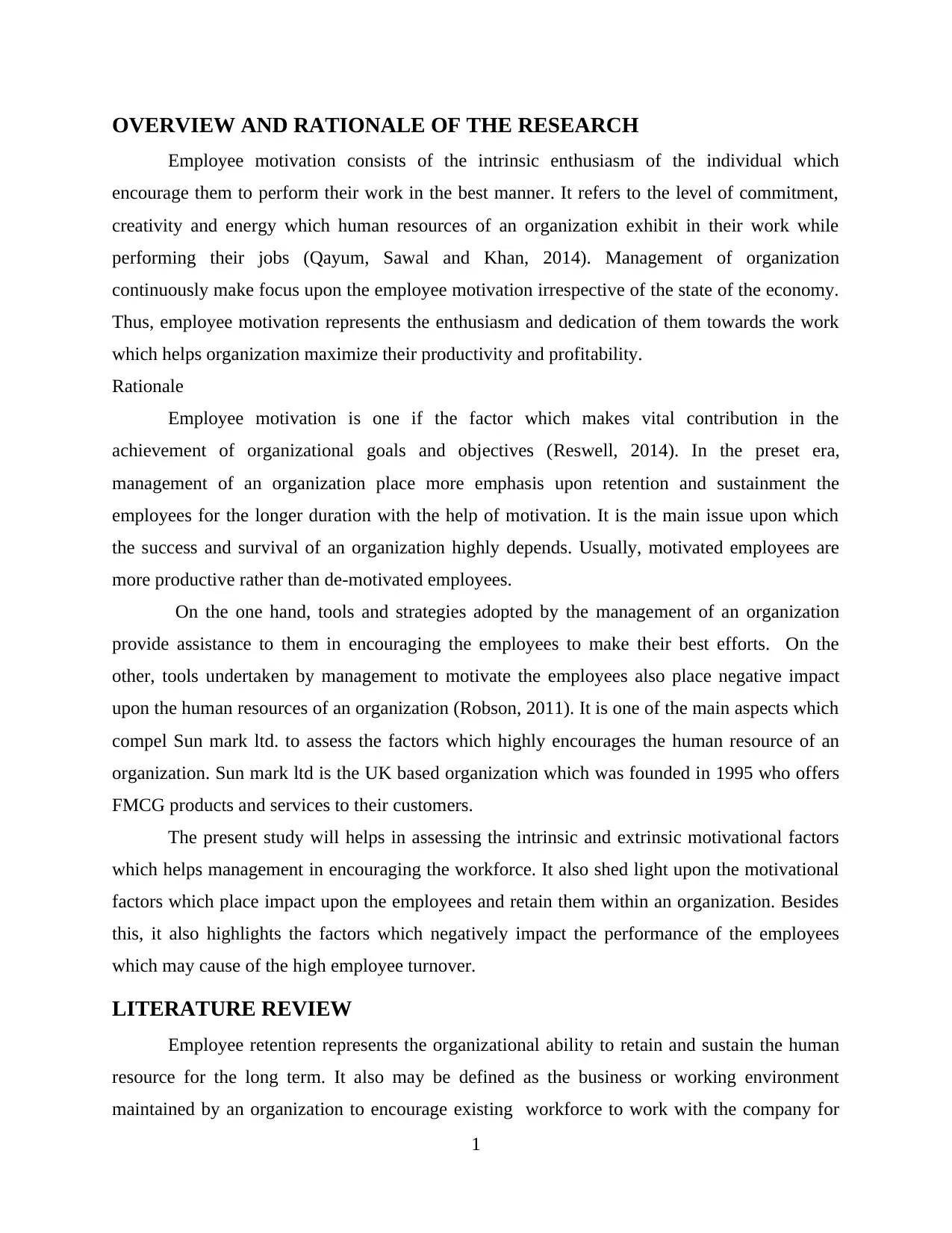
OVERVIEW AND RATIONALE OF THE RESEARCH
Employee motivation consists of the intrinsic enthusiasm of the individual which
encourage them to perform their work in the best manner. It refers to the level of commitment,
creativity and energy which human resources of an organization exhibit in their work while
performing their jobs (Qayum, Sawal and Khan, 2014). Management of organization
continuously make focus upon the employee motivation irrespective of the state of the economy.
Thus, employee motivation represents the enthusiasm and dedication of them towards the work
which helps organization maximize their productivity and profitability.
Rationale
Employee motivation is one if the factor which makes vital contribution in the
achievement of organizational goals and objectives (Reswell, 2014). In the preset era,
management of an organization place more emphasis upon retention and sustainment the
employees for the longer duration with the help of motivation. It is the main issue upon which
the success and survival of an organization highly depends. Usually, motivated employees are
more productive rather than de-motivated employees.
On the one hand, tools and strategies adopted by the management of an organization
provide assistance to them in encouraging the employees to make their best efforts. On the
other, tools undertaken by management to motivate the employees also place negative impact
upon the human resources of an organization (Robson, 2011). It is one of the main aspects which
compel Sun mark ltd. to assess the factors which highly encourages the human resource of an
organization. Sun mark ltd is the UK based organization which was founded in 1995 who offers
FMCG products and services to their customers.
The present study will helps in assessing the intrinsic and extrinsic motivational factors
which helps management in encouraging the workforce. It also shed light upon the motivational
factors which place impact upon the employees and retain them within an organization. Besides
this, it also highlights the factors which negatively impact the performance of the employees
which may cause of the high employee turnover.
LITERATURE REVIEW
Employee retention represents the organizational ability to retain and sustain the human
resource for the long term. It also may be defined as the business or working environment
maintained by an organization to encourage existing workforce to work with the company for
1
Employee motivation consists of the intrinsic enthusiasm of the individual which
encourage them to perform their work in the best manner. It refers to the level of commitment,
creativity and energy which human resources of an organization exhibit in their work while
performing their jobs (Qayum, Sawal and Khan, 2014). Management of organization
continuously make focus upon the employee motivation irrespective of the state of the economy.
Thus, employee motivation represents the enthusiasm and dedication of them towards the work
which helps organization maximize their productivity and profitability.
Rationale
Employee motivation is one if the factor which makes vital contribution in the
achievement of organizational goals and objectives (Reswell, 2014). In the preset era,
management of an organization place more emphasis upon retention and sustainment the
employees for the longer duration with the help of motivation. It is the main issue upon which
the success and survival of an organization highly depends. Usually, motivated employees are
more productive rather than de-motivated employees.
On the one hand, tools and strategies adopted by the management of an organization
provide assistance to them in encouraging the employees to make their best efforts. On the
other, tools undertaken by management to motivate the employees also place negative impact
upon the human resources of an organization (Robson, 2011). It is one of the main aspects which
compel Sun mark ltd. to assess the factors which highly encourages the human resource of an
organization. Sun mark ltd is the UK based organization which was founded in 1995 who offers
FMCG products and services to their customers.
The present study will helps in assessing the intrinsic and extrinsic motivational factors
which helps management in encouraging the workforce. It also shed light upon the motivational
factors which place impact upon the employees and retain them within an organization. Besides
this, it also highlights the factors which negatively impact the performance of the employees
which may cause of the high employee turnover.
LITERATURE REVIEW
Employee retention represents the organizational ability to retain and sustain the human
resource for the long term. It also may be defined as the business or working environment
maintained by an organization to encourage existing workforce to work with the company for
1
Paraphrase This Document
Need a fresh take? Get an instant paraphrase of this document with our AI Paraphraser
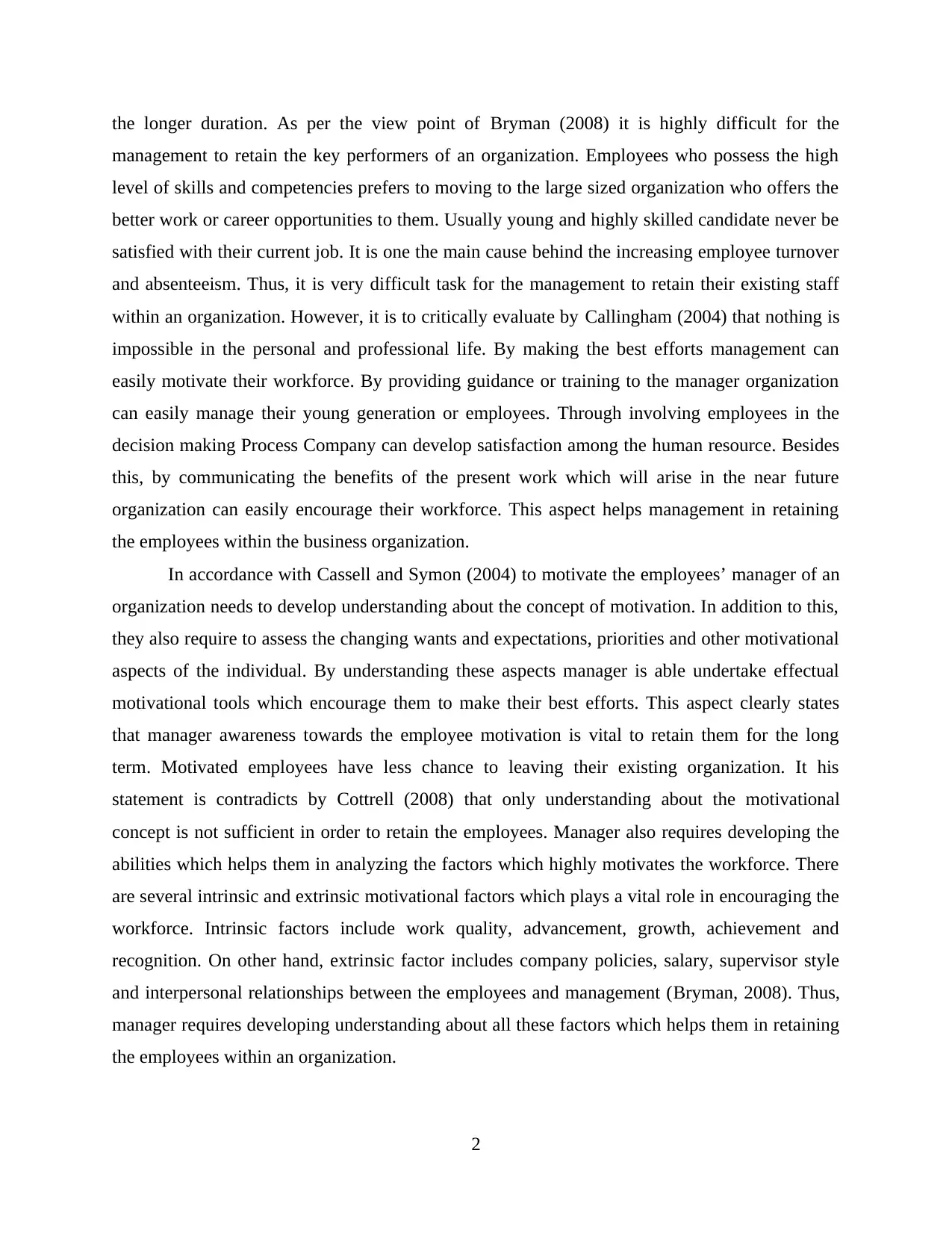
the longer duration. As per the view point of Bryman (2008) it is highly difficult for the
management to retain the key performers of an organization. Employees who possess the high
level of skills and competencies prefers to moving to the large sized organization who offers the
better work or career opportunities to them. Usually young and highly skilled candidate never be
satisfied with their current job. It is one the main cause behind the increasing employee turnover
and absenteeism. Thus, it is very difficult task for the management to retain their existing staff
within an organization. However, it is to critically evaluate by Callingham (2004) that nothing is
impossible in the personal and professional life. By making the best efforts management can
easily motivate their workforce. By providing guidance or training to the manager organization
can easily manage their young generation or employees. Through involving employees in the
decision making Process Company can develop satisfaction among the human resource. Besides
this, by communicating the benefits of the present work which will arise in the near future
organization can easily encourage their workforce. This aspect helps management in retaining
the employees within the business organization.
In accordance with Cassell and Symon (2004) to motivate the employees’ manager of an
organization needs to develop understanding about the concept of motivation. In addition to this,
they also require to assess the changing wants and expectations, priorities and other motivational
aspects of the individual. By understanding these aspects manager is able undertake effectual
motivational tools which encourage them to make their best efforts. This aspect clearly states
that manager awareness towards the employee motivation is vital to retain them for the long
term. Motivated employees have less chance to leaving their existing organization. It his
statement is contradicts by Cottrell (2008) that only understanding about the motivational
concept is not sufficient in order to retain the employees. Manager also requires developing the
abilities which helps them in analyzing the factors which highly motivates the workforce. There
are several intrinsic and extrinsic motivational factors which plays a vital role in encouraging the
workforce. Intrinsic factors include work quality, advancement, growth, achievement and
recognition. On other hand, extrinsic factor includes company policies, salary, supervisor style
and interpersonal relationships between the employees and management (Bryman, 2008). Thus,
manager requires developing understanding about all these factors which helps them in retaining
the employees within an organization.
2
management to retain the key performers of an organization. Employees who possess the high
level of skills and competencies prefers to moving to the large sized organization who offers the
better work or career opportunities to them. Usually young and highly skilled candidate never be
satisfied with their current job. It is one the main cause behind the increasing employee turnover
and absenteeism. Thus, it is very difficult task for the management to retain their existing staff
within an organization. However, it is to critically evaluate by Callingham (2004) that nothing is
impossible in the personal and professional life. By making the best efforts management can
easily motivate their workforce. By providing guidance or training to the manager organization
can easily manage their young generation or employees. Through involving employees in the
decision making Process Company can develop satisfaction among the human resource. Besides
this, by communicating the benefits of the present work which will arise in the near future
organization can easily encourage their workforce. This aspect helps management in retaining
the employees within the business organization.
In accordance with Cassell and Symon (2004) to motivate the employees’ manager of an
organization needs to develop understanding about the concept of motivation. In addition to this,
they also require to assess the changing wants and expectations, priorities and other motivational
aspects of the individual. By understanding these aspects manager is able undertake effectual
motivational tools which encourage them to make their best efforts. This aspect clearly states
that manager awareness towards the employee motivation is vital to retain them for the long
term. Motivated employees have less chance to leaving their existing organization. It his
statement is contradicts by Cottrell (2008) that only understanding about the motivational
concept is not sufficient in order to retain the employees. Manager also requires developing the
abilities which helps them in analyzing the factors which highly motivates the workforce. There
are several intrinsic and extrinsic motivational factors which plays a vital role in encouraging the
workforce. Intrinsic factors include work quality, advancement, growth, achievement and
recognition. On other hand, extrinsic factor includes company policies, salary, supervisor style
and interpersonal relationships between the employees and management (Bryman, 2008). Thus,
manager requires developing understanding about all these factors which helps them in retaining
the employees within an organization.
2
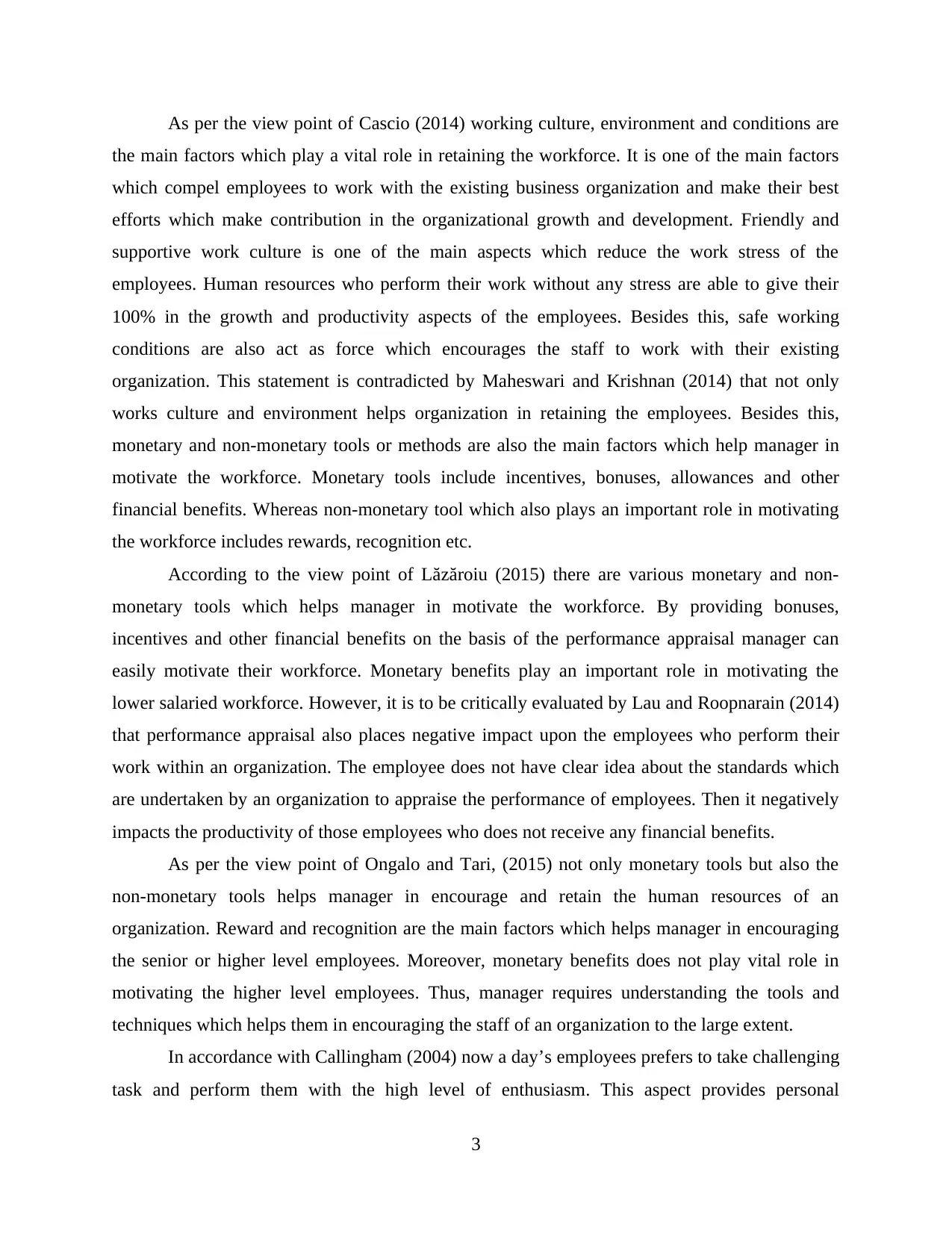
As per the view point of Cascio (2014) working culture, environment and conditions are
the main factors which play a vital role in retaining the workforce. It is one of the main factors
which compel employees to work with the existing business organization and make their best
efforts which make contribution in the organizational growth and development. Friendly and
supportive work culture is one of the main aspects which reduce the work stress of the
employees. Human resources who perform their work without any stress are able to give their
100% in the growth and productivity aspects of the employees. Besides this, safe working
conditions are also act as force which encourages the staff to work with their existing
organization. This statement is contradicted by Maheswari and Krishnan (2014) that not only
works culture and environment helps organization in retaining the employees. Besides this,
monetary and non-monetary tools or methods are also the main factors which help manager in
motivate the workforce. Monetary tools include incentives, bonuses, allowances and other
financial benefits. Whereas non-monetary tool which also plays an important role in motivating
the workforce includes rewards, recognition etc.
According to the view point of Lăzăroiu (2015) there are various monetary and non-
monetary tools which helps manager in motivate the workforce. By providing bonuses,
incentives and other financial benefits on the basis of the performance appraisal manager can
easily motivate their workforce. Monetary benefits play an important role in motivating the
lower salaried workforce. However, it is to be critically evaluated by Lau and Roopnarain (2014)
that performance appraisal also places negative impact upon the employees who perform their
work within an organization. The employee does not have clear idea about the standards which
are undertaken by an organization to appraise the performance of employees. Then it negatively
impacts the productivity of those employees who does not receive any financial benefits.
As per the view point of Ongalo and Tari, (2015) not only monetary tools but also the
non-monetary tools helps manager in encourage and retain the human resources of an
organization. Reward and recognition are the main factors which helps manager in encouraging
the senior or higher level employees. Moreover, monetary benefits does not play vital role in
motivating the higher level employees. Thus, manager requires understanding the tools and
techniques which helps them in encouraging the staff of an organization to the large extent.
In accordance with Callingham (2004) now a day’s employees prefers to take challenging
task and perform them with the high level of enthusiasm. This aspect provides personal
3
the main factors which play a vital role in retaining the workforce. It is one of the main factors
which compel employees to work with the existing business organization and make their best
efforts which make contribution in the organizational growth and development. Friendly and
supportive work culture is one of the main aspects which reduce the work stress of the
employees. Human resources who perform their work without any stress are able to give their
100% in the growth and productivity aspects of the employees. Besides this, safe working
conditions are also act as force which encourages the staff to work with their existing
organization. This statement is contradicted by Maheswari and Krishnan (2014) that not only
works culture and environment helps organization in retaining the employees. Besides this,
monetary and non-monetary tools or methods are also the main factors which help manager in
motivate the workforce. Monetary tools include incentives, bonuses, allowances and other
financial benefits. Whereas non-monetary tool which also plays an important role in motivating
the workforce includes rewards, recognition etc.
According to the view point of Lăzăroiu (2015) there are various monetary and non-
monetary tools which helps manager in motivate the workforce. By providing bonuses,
incentives and other financial benefits on the basis of the performance appraisal manager can
easily motivate their workforce. Monetary benefits play an important role in motivating the
lower salaried workforce. However, it is to be critically evaluated by Lau and Roopnarain (2014)
that performance appraisal also places negative impact upon the employees who perform their
work within an organization. The employee does not have clear idea about the standards which
are undertaken by an organization to appraise the performance of employees. Then it negatively
impacts the productivity of those employees who does not receive any financial benefits.
As per the view point of Ongalo and Tari, (2015) not only monetary tools but also the
non-monetary tools helps manager in encourage and retain the human resources of an
organization. Reward and recognition are the main factors which helps manager in encouraging
the senior or higher level employees. Moreover, monetary benefits does not play vital role in
motivating the higher level employees. Thus, manager requires understanding the tools and
techniques which helps them in encouraging the staff of an organization to the large extent.
In accordance with Callingham (2004) now a day’s employees prefers to take challenging
task and perform them with the high level of enthusiasm. This aspect provides personal
3
⊘ This is a preview!⊘
Do you want full access?
Subscribe today to unlock all pages.

Trusted by 1+ million students worldwide
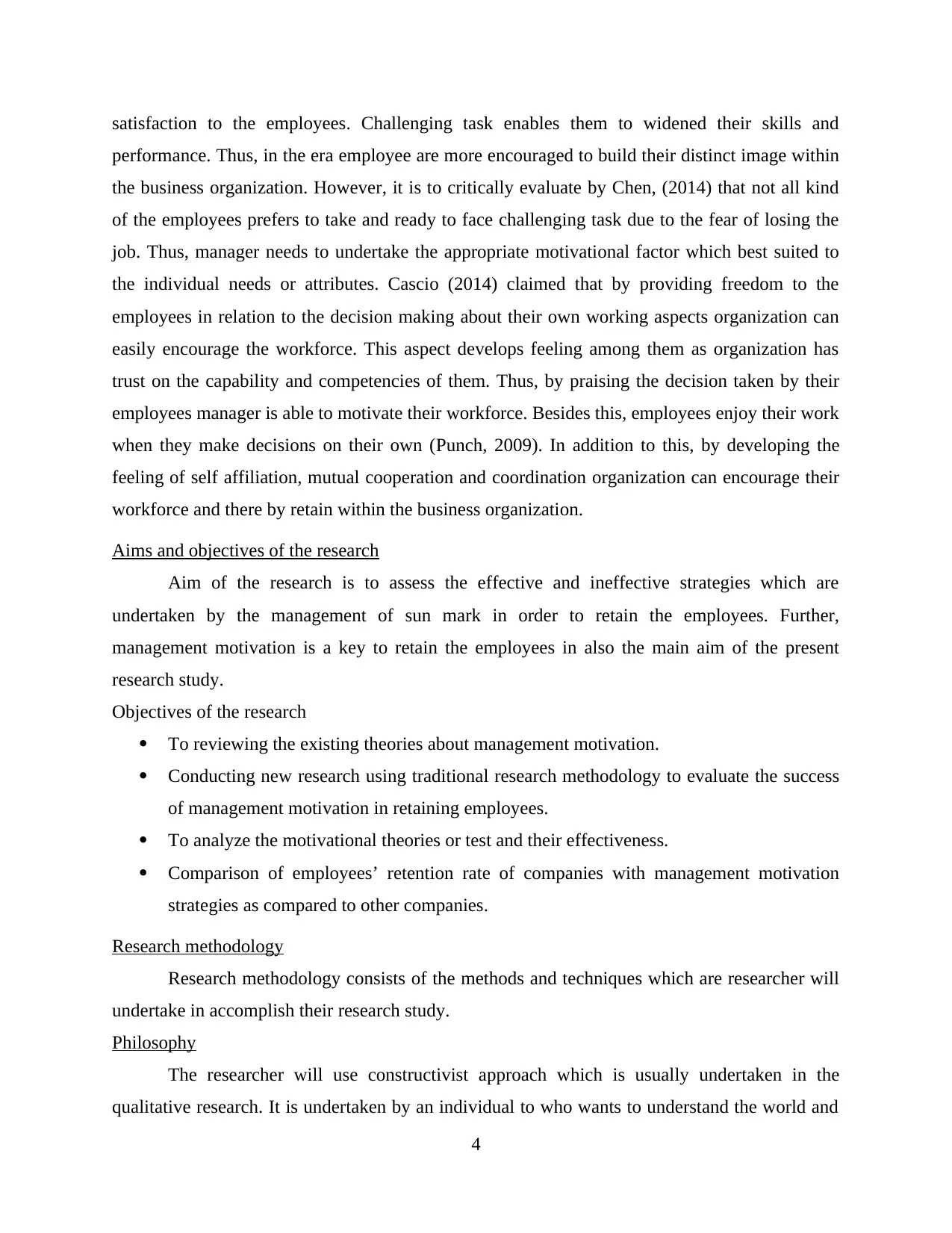
satisfaction to the employees. Challenging task enables them to widened their skills and
performance. Thus, in the era employee are more encouraged to build their distinct image within
the business organization. However, it is to critically evaluate by Chen, (2014) that not all kind
of the employees prefers to take and ready to face challenging task due to the fear of losing the
job. Thus, manager needs to undertake the appropriate motivational factor which best suited to
the individual needs or attributes. Cascio (2014) claimed that by providing freedom to the
employees in relation to the decision making about their own working aspects organization can
easily encourage the workforce. This aspect develops feeling among them as organization has
trust on the capability and competencies of them. Thus, by praising the decision taken by their
employees manager is able to motivate their workforce. Besides this, employees enjoy their work
when they make decisions on their own (Punch, 2009). In addition to this, by developing the
feeling of self affiliation, mutual cooperation and coordination organization can encourage their
workforce and there by retain within the business organization.
Aims and objectives of the research
Aim of the research is to assess the effective and ineffective strategies which are
undertaken by the management of sun mark in order to retain the employees. Further,
management motivation is a key to retain the employees in also the main aim of the present
research study.
Objectives of the research
To reviewing the existing theories about management motivation.
Conducting new research using traditional research methodology to evaluate the success
of management motivation in retaining employees.
To analyze the motivational theories or test and their effectiveness.
Comparison of employees’ retention rate of companies with management motivation
strategies as compared to other companies.
Research methodology
Research methodology consists of the methods and techniques which are researcher will
undertake in accomplish their research study.
Philosophy
The researcher will use constructivist approach which is usually undertaken in the
qualitative research. It is undertaken by an individual to who wants to understand the world and
4
performance. Thus, in the era employee are more encouraged to build their distinct image within
the business organization. However, it is to critically evaluate by Chen, (2014) that not all kind
of the employees prefers to take and ready to face challenging task due to the fear of losing the
job. Thus, manager needs to undertake the appropriate motivational factor which best suited to
the individual needs or attributes. Cascio (2014) claimed that by providing freedom to the
employees in relation to the decision making about their own working aspects organization can
easily encourage the workforce. This aspect develops feeling among them as organization has
trust on the capability and competencies of them. Thus, by praising the decision taken by their
employees manager is able to motivate their workforce. Besides this, employees enjoy their work
when they make decisions on their own (Punch, 2009). In addition to this, by developing the
feeling of self affiliation, mutual cooperation and coordination organization can encourage their
workforce and there by retain within the business organization.
Aims and objectives of the research
Aim of the research is to assess the effective and ineffective strategies which are
undertaken by the management of sun mark in order to retain the employees. Further,
management motivation is a key to retain the employees in also the main aim of the present
research study.
Objectives of the research
To reviewing the existing theories about management motivation.
Conducting new research using traditional research methodology to evaluate the success
of management motivation in retaining employees.
To analyze the motivational theories or test and their effectiveness.
Comparison of employees’ retention rate of companies with management motivation
strategies as compared to other companies.
Research methodology
Research methodology consists of the methods and techniques which are researcher will
undertake in accomplish their research study.
Philosophy
The researcher will use constructivist approach which is usually undertaken in the
qualitative research. It is undertaken by an individual to who wants to understand the world and
4
Paraphrase This Document
Need a fresh take? Get an instant paraphrase of this document with our AI Paraphraser
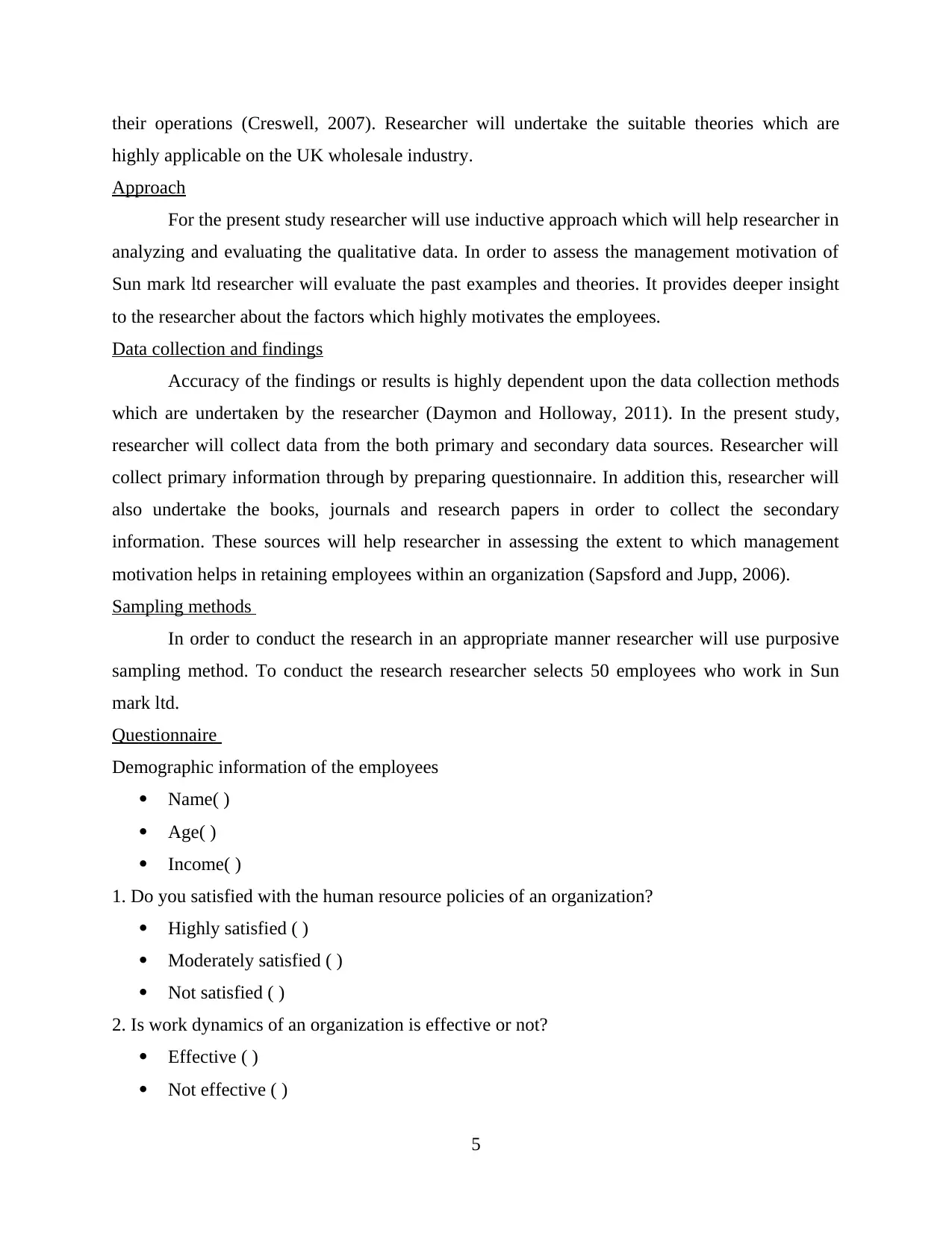
their operations (Creswell, 2007). Researcher will undertake the suitable theories which are
highly applicable on the UK wholesale industry.
Approach
For the present study researcher will use inductive approach which will help researcher in
analyzing and evaluating the qualitative data. In order to assess the management motivation of
Sun mark ltd researcher will evaluate the past examples and theories. It provides deeper insight
to the researcher about the factors which highly motivates the employees.
Data collection and findings
Accuracy of the findings or results is highly dependent upon the data collection methods
which are undertaken by the researcher (Daymon and Holloway, 2011). In the present study,
researcher will collect data from the both primary and secondary data sources. Researcher will
collect primary information through by preparing questionnaire. In addition this, researcher will
also undertake the books, journals and research papers in order to collect the secondary
information. These sources will help researcher in assessing the extent to which management
motivation helps in retaining employees within an organization (Sapsford and Jupp, 2006).
Sampling methods
In order to conduct the research in an appropriate manner researcher will use purposive
sampling method. To conduct the research researcher selects 50 employees who work in Sun
mark ltd.
Questionnaire
Demographic information of the employees
Name( )
Age( )
Income( )
1. Do you satisfied with the human resource policies of an organization?
Highly satisfied ( )
Moderately satisfied ( )
Not satisfied ( )
2. Is work dynamics of an organization is effective or not?
Effective ( )
Not effective ( )
5
highly applicable on the UK wholesale industry.
Approach
For the present study researcher will use inductive approach which will help researcher in
analyzing and evaluating the qualitative data. In order to assess the management motivation of
Sun mark ltd researcher will evaluate the past examples and theories. It provides deeper insight
to the researcher about the factors which highly motivates the employees.
Data collection and findings
Accuracy of the findings or results is highly dependent upon the data collection methods
which are undertaken by the researcher (Daymon and Holloway, 2011). In the present study,
researcher will collect data from the both primary and secondary data sources. Researcher will
collect primary information through by preparing questionnaire. In addition this, researcher will
also undertake the books, journals and research papers in order to collect the secondary
information. These sources will help researcher in assessing the extent to which management
motivation helps in retaining employees within an organization (Sapsford and Jupp, 2006).
Sampling methods
In order to conduct the research in an appropriate manner researcher will use purposive
sampling method. To conduct the research researcher selects 50 employees who work in Sun
mark ltd.
Questionnaire
Demographic information of the employees
Name( )
Age( )
Income( )
1. Do you satisfied with the human resource policies of an organization?
Highly satisfied ( )
Moderately satisfied ( )
Not satisfied ( )
2. Is work dynamics of an organization is effective or not?
Effective ( )
Not effective ( )
5
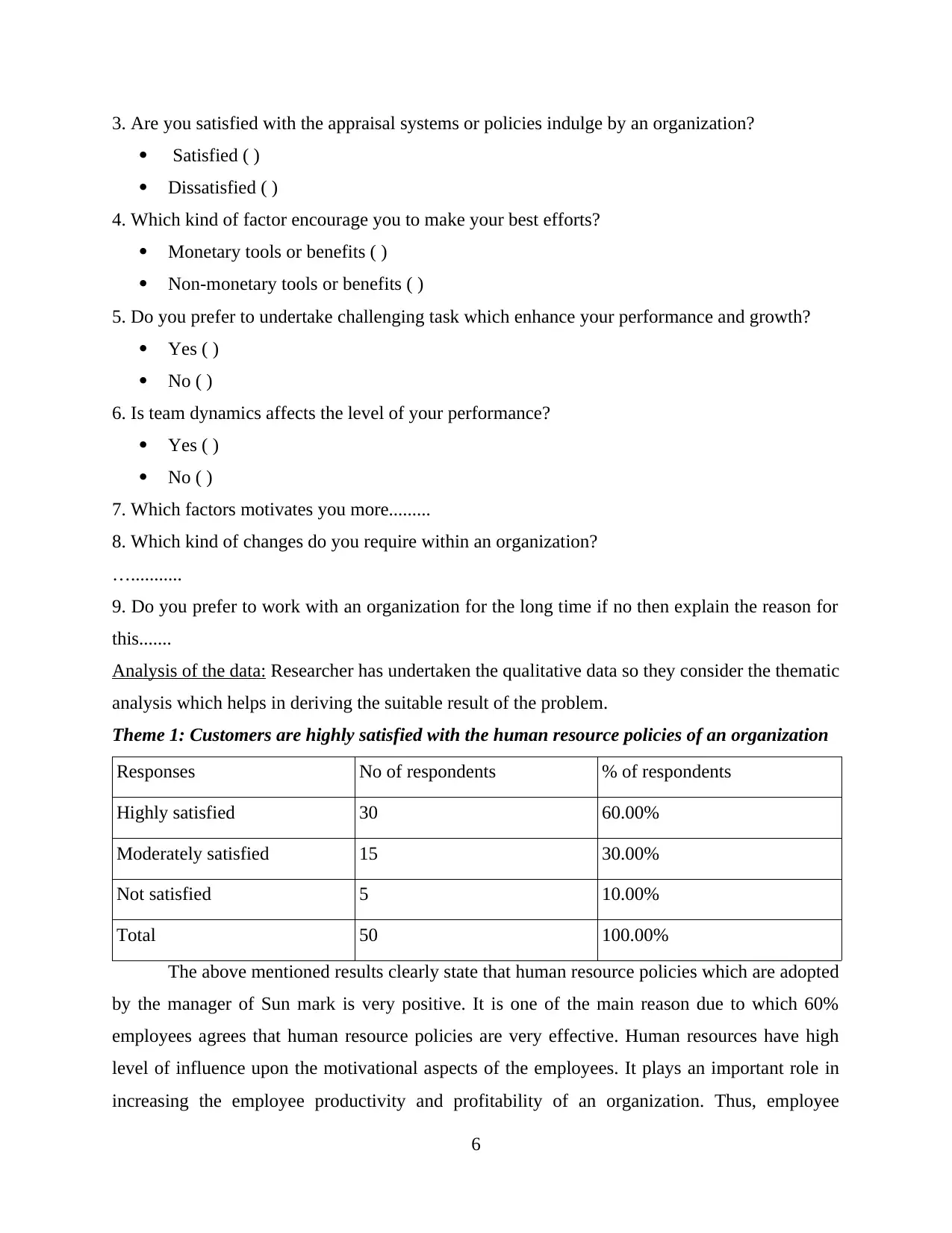
3. Are you satisfied with the appraisal systems or policies indulge by an organization?
Satisfied ( )
Dissatisfied ( )
4. Which kind of factor encourage you to make your best efforts?
Monetary tools or benefits ( )
Non-monetary tools or benefits ( )
5. Do you prefer to undertake challenging task which enhance your performance and growth?
Yes ( )
No ( )
6. Is team dynamics affects the level of your performance?
Yes ( )
No ( )
7. Which factors motivates you more.........
8. Which kind of changes do you require within an organization?
…...........
9. Do you prefer to work with an organization for the long time if no then explain the reason for
this.......
Analysis of the data: Researcher has undertaken the qualitative data so they consider the thematic
analysis which helps in deriving the suitable result of the problem.
Theme 1: Customers are highly satisfied with the human resource policies of an organization
Responses No of respondents % of respondents
Highly satisfied 30 60.00%
Moderately satisfied 15 30.00%
Not satisfied 5 10.00%
Total 50 100.00%
The above mentioned results clearly state that human resource policies which are adopted
by the manager of Sun mark is very positive. It is one of the main reason due to which 60%
employees agrees that human resource policies are very effective. Human resources have high
level of influence upon the motivational aspects of the employees. It plays an important role in
increasing the employee productivity and profitability of an organization. Thus, employee
6
Satisfied ( )
Dissatisfied ( )
4. Which kind of factor encourage you to make your best efforts?
Monetary tools or benefits ( )
Non-monetary tools or benefits ( )
5. Do you prefer to undertake challenging task which enhance your performance and growth?
Yes ( )
No ( )
6. Is team dynamics affects the level of your performance?
Yes ( )
No ( )
7. Which factors motivates you more.........
8. Which kind of changes do you require within an organization?
…...........
9. Do you prefer to work with an organization for the long time if no then explain the reason for
this.......
Analysis of the data: Researcher has undertaken the qualitative data so they consider the thematic
analysis which helps in deriving the suitable result of the problem.
Theme 1: Customers are highly satisfied with the human resource policies of an organization
Responses No of respondents % of respondents
Highly satisfied 30 60.00%
Moderately satisfied 15 30.00%
Not satisfied 5 10.00%
Total 50 100.00%
The above mentioned results clearly state that human resource policies which are adopted
by the manager of Sun mark is very positive. It is one of the main reason due to which 60%
employees agrees that human resource policies are very effective. Human resources have high
level of influence upon the motivational aspects of the employees. It plays an important role in
increasing the employee productivity and profitability of an organization. Thus, employee
6
⊘ This is a preview!⊘
Do you want full access?
Subscribe today to unlock all pages.

Trusted by 1+ million students worldwide
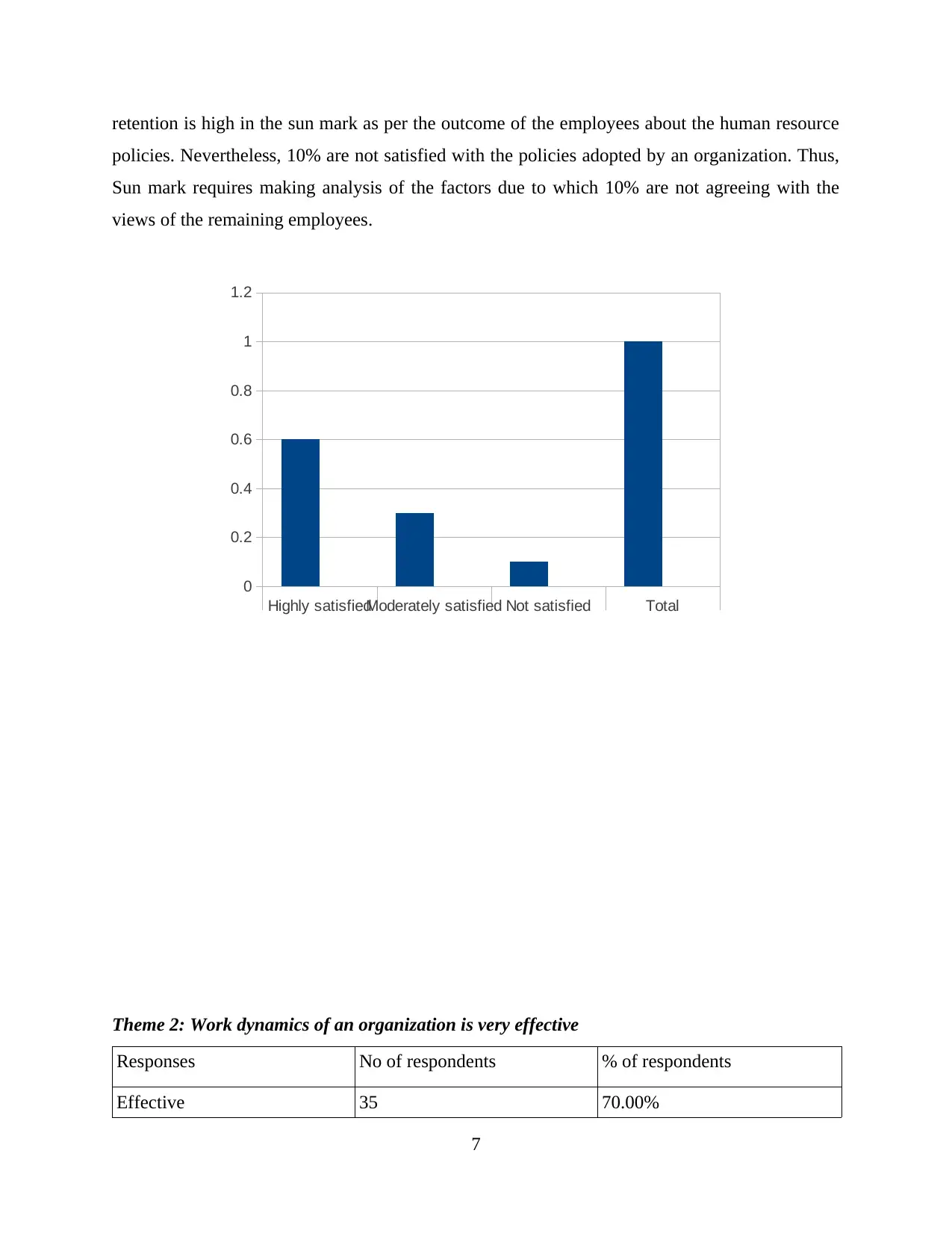
retention is high in the sun mark as per the outcome of the employees about the human resource
policies. Nevertheless, 10% are not satisfied with the policies adopted by an organization. Thus,
Sun mark requires making analysis of the factors due to which 10% are not agreeing with the
views of the remaining employees.
Theme 2: Work dynamics of an organization is very effective
Responses No of respondents % of respondents
Effective 35 70.00%
7
Highly satisfiedModerately satisfied Not satisfied Total
0
0.2
0.4
0.6
0.8
1
1.2
policies. Nevertheless, 10% are not satisfied with the policies adopted by an organization. Thus,
Sun mark requires making analysis of the factors due to which 10% are not agreeing with the
views of the remaining employees.
Theme 2: Work dynamics of an organization is very effective
Responses No of respondents % of respondents
Effective 35 70.00%
7
Highly satisfiedModerately satisfied Not satisfied Total
0
0.2
0.4
0.6
0.8
1
1.2
Paraphrase This Document
Need a fresh take? Get an instant paraphrase of this document with our AI Paraphraser
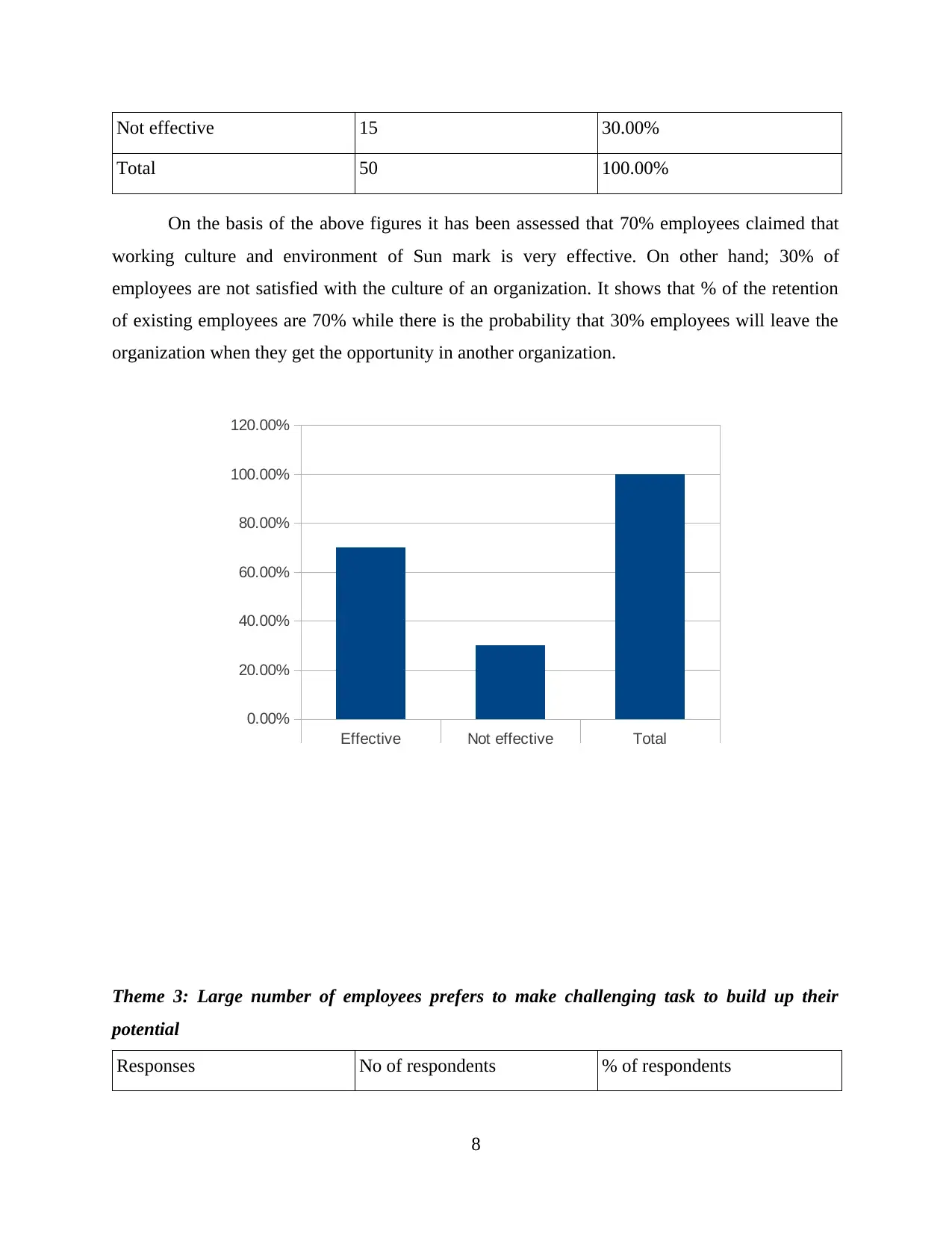
Not effective 15 30.00%
Total 50 100.00%
On the basis of the above figures it has been assessed that 70% employees claimed that
working culture and environment of Sun mark is very effective. On other hand; 30% of
employees are not satisfied with the culture of an organization. It shows that % of the retention
of existing employees are 70% while there is the probability that 30% employees will leave the
organization when they get the opportunity in another organization.
Theme 3: Large number of employees prefers to make challenging task to build up their
potential
Responses No of respondents % of respondents
8
Effective Not effective Total
0.00%
20.00%
40.00%
60.00%
80.00%
100.00%
120.00%
Total 50 100.00%
On the basis of the above figures it has been assessed that 70% employees claimed that
working culture and environment of Sun mark is very effective. On other hand; 30% of
employees are not satisfied with the culture of an organization. It shows that % of the retention
of existing employees are 70% while there is the probability that 30% employees will leave the
organization when they get the opportunity in another organization.
Theme 3: Large number of employees prefers to make challenging task to build up their
potential
Responses No of respondents % of respondents
8
Effective Not effective Total
0.00%
20.00%
40.00%
60.00%
80.00%
100.00%
120.00%
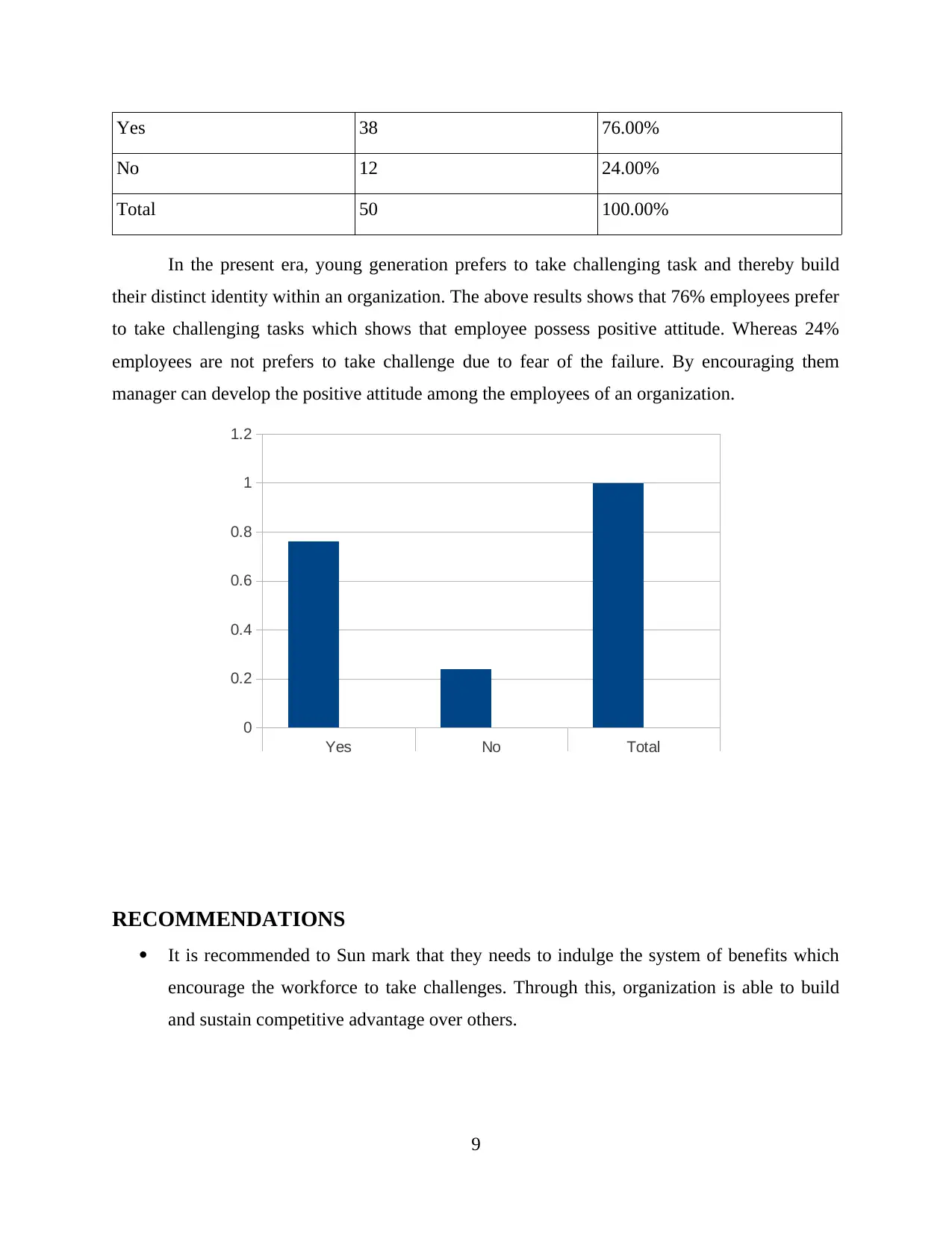
Yes 38 76.00%
No 12 24.00%
Total 50 100.00%
In the present era, young generation prefers to take challenging task and thereby build
their distinct identity within an organization. The above results shows that 76% employees prefer
to take challenging tasks which shows that employee possess positive attitude. Whereas 24%
employees are not prefers to take challenge due to fear of the failure. By encouraging them
manager can develop the positive attitude among the employees of an organization.
RECOMMENDATIONS
It is recommended to Sun mark that they needs to indulge the system of benefits which
encourage the workforce to take challenges. Through this, organization is able to build
and sustain competitive advantage over others.
9
Yes No Total
0
0.2
0.4
0.6
0.8
1
1.2
No 12 24.00%
Total 50 100.00%
In the present era, young generation prefers to take challenging task and thereby build
their distinct identity within an organization. The above results shows that 76% employees prefer
to take challenging tasks which shows that employee possess positive attitude. Whereas 24%
employees are not prefers to take challenge due to fear of the failure. By encouraging them
manager can develop the positive attitude among the employees of an organization.
RECOMMENDATIONS
It is recommended to Sun mark that they needs to indulge the system of benefits which
encourage the workforce to take challenges. Through this, organization is able to build
and sustain competitive advantage over others.
9
Yes No Total
0
0.2
0.4
0.6
0.8
1
1.2
⊘ This is a preview!⊘
Do you want full access?
Subscribe today to unlock all pages.

Trusted by 1+ million students worldwide
1 out of 15
Related Documents
Your All-in-One AI-Powered Toolkit for Academic Success.
+13062052269
info@desklib.com
Available 24*7 on WhatsApp / Email
![[object Object]](/_next/static/media/star-bottom.7253800d.svg)
Unlock your academic potential
Copyright © 2020–2025 A2Z Services. All Rights Reserved. Developed and managed by ZUCOL.





